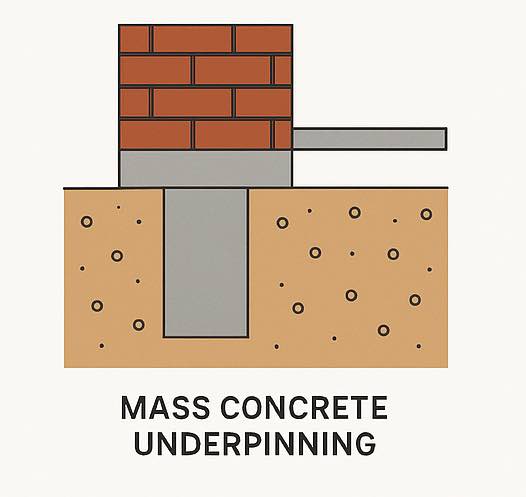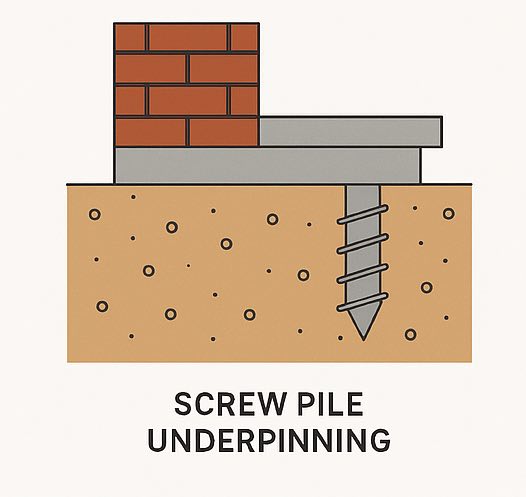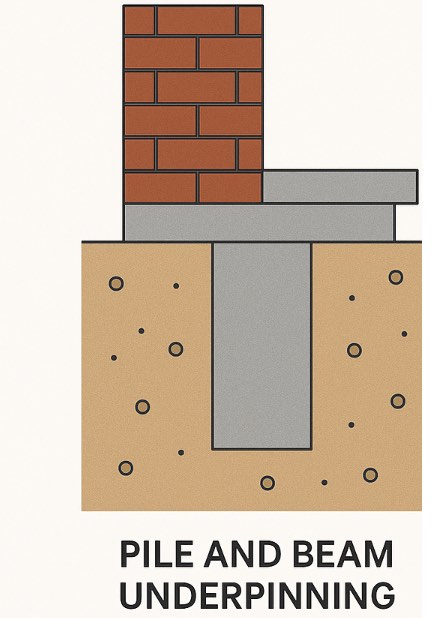What is Underpinning?
Underpinning is a foundation repair method designed to stabilise, strengthen, and sometimes deepen the existing foundations of your home.
Rather than replacing the entire foundation, underpinning supports what’s already there, giving your home a solid base to stand on for years to come.
Underpinning vs Restumping: What’s the Difference?
It’s easy to confuse underpinning with restumping (reblocking), they’re both foundation repair methods, but designed for different foundation types.
- Underpinning is for homes built on concrete slabs or strip footings, typically brick veneer or double brick houses. It reinforces existing foundations when they start to sink or shift.
- Restumping is for raised homes sitting on timber, concrete, or steel stumps, common in older weatherboard houses. When stumps deteriorate or settle unevenly, they need replacing.
Quick Comparison Table
| Aspect | Underpinning | Restumping (Reblocking) |
| Foundation Type | Concrete slabs or strip footings | Timber, concrete, or steel stumps |
| Typical Structures | Brick veneer, double brick homes | Raised weatherboard homes |
| Purpose | Stabilise and strengthen existing foundation | Replace deteriorated stumps |
| Common Methods | Mass concrete, screw piles, resin injection | Full or partial stump replacement |
| When Needed | Foundation movement, cracks, uneven floors | Sloping floors, sticking doors/windows |
If you’re unsure which applies to your home, a professional inspection will quickly point you in the right direction.
How Does Underpinning Work?
Underpinning is a tailored process. No two homes or soil conditions are exactly the same. The method depends on your property’s structure, the ground beneath it, and how much foundation movement has occurred. But generally, underpinning follows these key steps:
1. Inspection, Soil Testing & Engineering Design
Every job begins with a detailed site inspection to assess the foundation issues. A soil test identifies how stable the ground is, which is crucial for choosing the right underpinning method. From there, a structural engineer designs a customised solution that’s safe, effective, and compliant with Australian Standards.
2. Targeted Excavation
Small sections beneath or beside your footings (called pins) are carefully excavated. This is done in stages to keep your home stable throughout the process. The depth and size of these excavations depend on the engineer’s plan and the chosen reinforcement method.
3. Foundation Reinforcement
Here’s where your foundation gets its strength back. Depending on what’s best for your home, we’ll either:
- Pour concrete to deepen and stabilise the footing,
- Install screw piles to anchor into stable ground,
- Or inject expanding resin to fill voids and lift sunken areas.
4. Final Checks, Backfill & Certification
Once the reinforcement is complete, we check that everything is level and stable. The excavated areas are backfilled and cleaned up. You’ll receive full certification, confirming that your foundation is now solid and meets all regulatory standards.
Common Underpinning Methods
Underpinning solutions aren’t one-size-fits-all. The right method depends on your home, soil conditions, and how serious the foundation issues are. Here’s a breakdown of the most common techniques, with detailed insights and quick summaries to help you understand what’s involved.
Mass Concrete Underpinning (The Traditional Way)
 This is the classic approach to underpinning. It involves digging beneath the existing foundation and pouring concrete to create a deeper, stronger base. It’s done in sections to keep your home stable throughout the process.
This is the classic approach to underpinning. It involves digging beneath the existing foundation and pouring concrete to create a deeper, stronger base. It’s done in sections to keep your home stable throughout the process.
Best suited for homes with shallow foundations and stable soil, it’s simple but effective when conditions are right.
- Ideal for shallow foundations
- Reliable and cost-effective
- Minimal equipment required
- Not suitable for deep or highly reactive soils
Beam and Base Underpinning
 Beam and base underpinning uses reinforced concrete beams to spread the weight of your home across solid concrete pads placed on stable ground. It’s a smart choice when the existing footing isn’t strong enough or the soil beneath is inconsistent.
Beam and base underpinning uses reinforced concrete beams to spread the weight of your home across solid concrete pads placed on stable ground. It’s a smart choice when the existing footing isn’t strong enough or the soil beneath is inconsistent.
This method requires careful engineering but offers excellent load distribution.
- Great for unstable or variable ground conditions
- Strengthens weak or failing foundations
- Provides even load distribution
- Involves more excavation and structural work
Mini-Piled Underpinning
 When shallow fixes won’t cut it, mini-piled underpinning steps in. This method drills small-diameter piles deep into stable ground, making it perfect for poor soil conditions or tight access areas.
When shallow fixes won’t cut it, mini-piled underpinning steps in. This method drills small-diameter piles deep into stable ground, making it perfect for poor soil conditions or tight access areas.
It’s commonly used for larger buildings or where deep foundation support is essential.
- Suitable for deep foundation support
- Works well in restricted access sites
- Handles poor or unpredictable soil conditions
- Requires specialised equipment and higher costs
Screw Pile Underpinning
 Fast, efficient, and clean. Screw piling involves driving steel shafts with helical blades deep into stable ground. Once installed, they provide immediate support, making this a popular modern underpinning option.
Fast, efficient, and clean. Screw piling involves driving steel shafts with helical blades deep into stable ground. Once installed, they provide immediate support, making this a popular modern underpinning option.
It’s ideal for projects needing quick turnaround with minimal site disturbance.
- Rapid installation with minimal excavation
- Immediate load-bearing capacity
- Perfect for tight or sensitive sites
- Not suitable for all soil types
Resin Injection (Chemical Underpinning)
 For smaller settlement problems, resin injection offers a non-invasive solution. Expanding resin fills voids and compacts loose soil, even lifting sunken areas in some cases.
For smaller settlement problems, resin injection offers a non-invasive solution. Expanding resin fills voids and compacts loose soil, even lifting sunken areas in some cases.
It’s quick, clean, and usually completed within a day, but it’s not designed for major structural issues.
- Fast and non-disruptive
- Ideal for minor settlement and void filling
- No heavy machinery or excavation needed
- Limited to smaller-scale foundation problems
Pile and Beam Underpinning

This heavy-duty method combines deep piles with reinforced beams to stabilise serious foundation issues. It’s often used when the soil near the surface is unreliable and the building requires strong, deep-set support.
While complex, it offers long-term stability for challenging sites.
- Designed for heavy structures and poor soils
- Transfers load to deep, stable ground
- Robust and long-lasting solution
- More complex and costly than other methods
Looking for Expert Underpinning Advice?
At Southern Stumping & Underpinning, we’ve been helping homeowners stabilise their foundations for over 50 years. From soil testing and engineering to permits and professional repairs, we handle the lot.
If you think your home might need underpinning, or you’re just after honest advice, we offer free inspections and clear, no-obligation quotes.
Talk to the experts today!
Get in touch for a no-obligation, free quote or advice on all your re-stumping or underpinning needs on your property.
or call us on 0425 435 164
Underpinning FAQ’s
How can I tell if my home needs underpinning?
Before you worry about cracks or sloping floors, it’s important to know what’s holding up your home. If your house is built on a concrete slab or strip footings (common in brick veneer, double brick, or modern slab homes), then underpinning is the solution when foundations start to shift or sink.
On the other hand, if you own a raised weatherboard home sitting on timber, concrete, or steel stumps, those same signs usually point to restumping instead.
No matter the foundation type, there are key warning signs to watch for:
- Cracks in walls, especially diagonal or widening cracks
- Doors and windows that stick or won’t close properly
- Floors that slope or feel uneven
- Gaps around window frames, doors, or skirting boards
If your home is brick or slab-based and you’re seeing these issues, there’s a good chance underpinning is needed to stabilise your foundation. If it’s a stumped, raised home, restumping is likely the answer.
Why do foundations start moving in the first place?
Most foundation problems aren’t caused by what you can see. It’s all about what’s happening under your home. If you’re living in an area with reactive clay soils (which is common across many parts of Australia), the ground naturally expands when wet and shrinks when dry. Over time, this constant movement puts pressure on your foundation.
Other common causes include poor drainage or leaking pipes, which can wash away the soil that’s supposed to be supporting your house. Big trees planted too close can pull moisture from the ground or physically shift the soil around your footings.
For older homes, the issue might be that the original foundations were never built to handle today’s conditions, especially with changing weather patterns, droughts, or heavy rains. Even nearby construction work or roadworks can unsettle the ground enough to cause problems.
In short, whether it’s nature, time, or human activity, your foundation is constantly dealing with forces that can cause it to sink, shift, or crack.
How Much Does Underpinning Cost?
The cost of underpinning can vary significantly depending on the specific conditions of your property. In Australia, prices generally start from around $5,000 for minor, straightforward projects. However, more complex jobs involving significant foundation movement, difficult soil conditions, or specialised underpinning methods can range between $15,000 to $30,000. In cases where extensive structural reinforcement is required, costs may exceed $50,000, though this is typically limited to larger properties or severe foundation issues.
Several factors influence the overall cost of underpinning, including:
- The extent and severity of foundation damage
- The underpinning method required (traditional concrete underpinning is generally more cost-effective than options like screw piling or resin injection)
- Soil conditions, particularly if the property is built on reactive or unstable ground
- Site accessibility, as limited access or obstructions can increase labor and equipment costs
- The size, design, and structural layout of the home
While underpinning represents a significant investment, addressing foundation issues early can prevent far greater expenses in the future. Delaying repairs often leads to worsening structural damage, higher rectification costs, and a negative impact on property value.
At Southern Stumping & Underpinning, we provide free inspections and detailed, transparent quotes tailored to your specific situation. This ensures you understand the scope of work and associated costs before making any commitments.
If you’re concerned about potential foundation problems, the best approach is to arrange a professional assessment. With us, that initial inspection is completely obligation-free.
How Long Does Underpinning Take?
No one wants their home to feel like a construction site for weeks on end. The good news is, underpinning doesn’t usually take as long as people think.
For most homes, you’re looking at anywhere between one to three weeks to get the job done. Smaller jobs with just a few underpinning points can sometimes be wrapped up in under a week. If your foundation needs more extensive work such as multiple reinforcement points or a more complex method like screw piling, it might stretch closer to that three-week mark.
Of course, several factors can influence the timeline. The underpinning method we use, site accessibility, and even the weather can all play a part, as rain and excavation don’t mix well.
Before we begin work, we’ll walk you through exactly what’s involved and give you a clear timeline. You’ll know when we’re starting, how long we’ll be around, and when you can get back to thinking about anything but your foundation.
And the best part? In most cases, you can stay in your home while we work, with minimal disruption to your day-to-day life.
Do I Need to Move Out During Underpinning Works?
In most cases, you won’t need to leave your home while underpinning is being carried out. The majority of underpinning projects are completed externally, around the perimeter of the property, or in specific targeted areas beneath the foundation.
Our team is experienced in working efficiently with minimal disruption to your daily routine. While there may be some noise and access requirements during the process, we take care to ensure that you can remain in your home safely and comfortably throughout the works.
For more complex projects, or in rare situations where internal access is required, we will discuss this with you in advance and outline any potential impact. However, for typical residential underpinning jobs, vacating the property is not necessary.
Do I Need Council Approval for Underpinning?
Yes, in most cases, council approval is required for underpinning works. Since underpinning involves structural repairs to your home’s foundation, it typically falls under local building regulations. This means permits, engineering designs, and compliance with Australian Standards are necessary before work can begin.
At Southern Stumping & Underpinning, we manage the entire approval process on your behalf. From obtaining permits to coordinating with structural engineers and ensuring full compliance, we handle all paperwork and regulatory requirements, allowing you to focus on securing your home without the administrative burden.
If you’re unsure about specific council requirements in your area, we can provide guidance during your initial consultation.
Will Underpinning Repair Existing Cracks in My Walls?
Underpinning is designed to stabilise your foundation and prevent any further structural movement. Once completed, it will stop new cracks from appearing due to subsidence or shifting foundations.
However, underpinning does not automatically close or repair existing cracks. Any visible damage to walls, ceilings, or brickwork will remain until cosmetic repairs are carried out separately. The benefit is that once your home is properly stabilised, you can confidently repair these cracks knowing they are unlikely to return due to foundation movement.
We always recommend waiting until underpinning is complete and the structure has fully settled before undertaking plastering or repainting work.
Talk to the experts today!
Get in touch for a no-obligation, free quote or advice on all your re-stumping or underpinning needs on your property.
or call us on 0425 435 164


